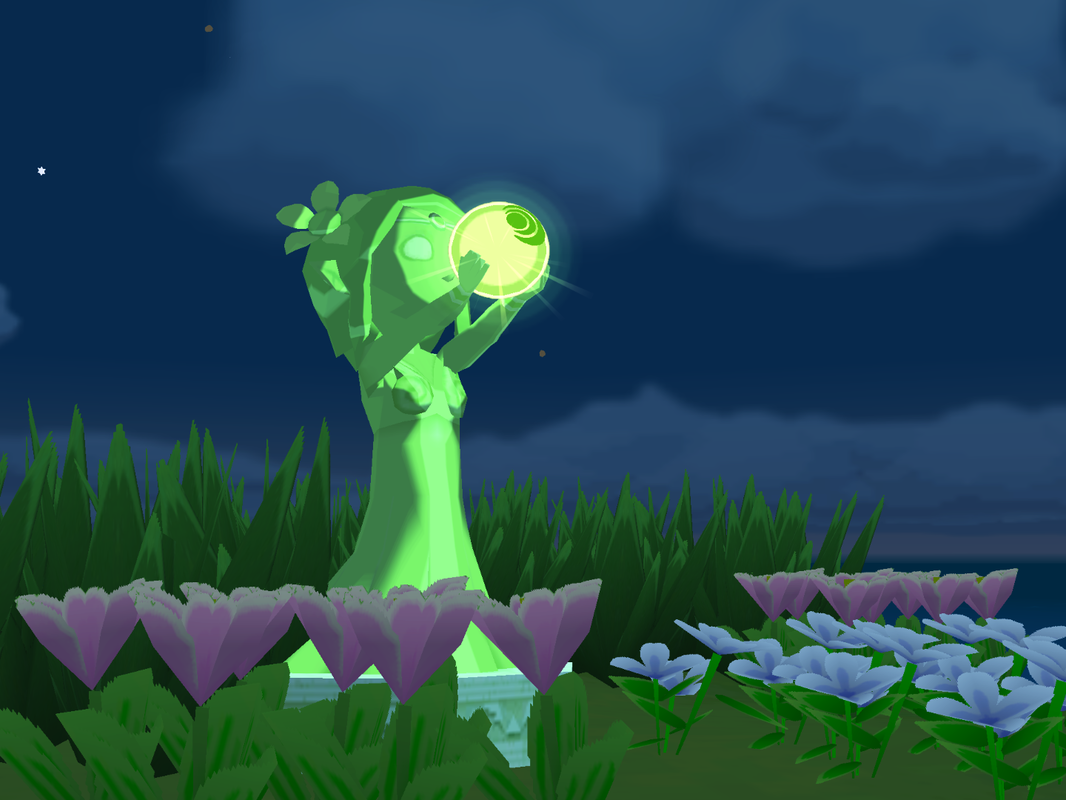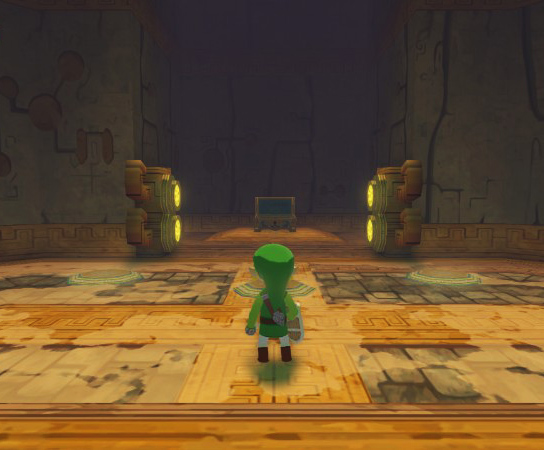Tower of the Gods
“This tower, which the pearls of the gods have caused to appear, is a place that the gods of the ancient world prepared so that they might test the courage of men. Only one who is able to overcome the trials that await there will be acknowledged as a true hero. Only then will that hero be permitted to wield the power to destroy the great evil.”
— The King of Red Lions, The Wind Waker
— The King of Red Lions, The Wind Waker
The Tower of the Gods is an ancient structure that rises from the sea in order to judge the courage of humanity. It is a testing ground, and a place of trial. Those that survive the tribulations within the tower gain the favor of the gods, and are chosen as embodiments of the greatest aspects of mankind. Interestingly, it is not known if natural skills and strength of character force the gods to recognize the heroic qualities innate in the survivor, or if the traveler comes to embody those abilities and personal qualities through undergoing hardship and winning eventual victory over the tower. What is known, in the end, is that those who pass the ordeals are the chosen of the gods. The tower appears and disappears based upon the needs of humanity; it exists for a very situational purpose, and its role is to continue the physical and spiritual preparation of the Hero.
Looking from afar upon the Tower of the Gods
Three statues, which act like shrines of offering, summon this structure from the murky depths, operating only when the corresponding Goddess Pearls have been placed in their hands. The islands that hold these icons, in conjunction with other far-flung islets, create the shape of the Triforce upon the face of the sea. When the Pearls are given unto these figures, the statues undergo a transformation; they change from vaguely humanoid, sexless beings with hollowed-out eyes to small statues of female bearing that raise aloft the heavenly pearls in order to draw forth the Tower of the Gods from beneath the ocean. As the goddess symbol upon each forehead portrays, each represents one of the three Golden Goddesses, corresponding in color to their respective pearl. Each is different in composure, although all manifest themselves as young girls, perhaps representing purity and innocence as well as reflecting the divine nature of the three deities.
This dungeon is one of light and water, and both elements play extremely important parts in the design of the building. This place is unique, in that it is not an island. It either rests upon the ocean floor or floats upon the surface of the water. The exterior can be divided into two parts: the ring of stones that forms the outer wall, and the tower itself. Encircling the main structure, which is itself steep and cylindrical, is a circular arcade, whose arches rise tall, and at even intervals. Above each arch rests a stone construct in the shape of either a hand bell, or a Buddhist stupa. In other Zelda games, most notably Twilight Princess, the symbol of the bell is used to invoke a sense of order and justice; as in the Temple of Time, the Tower of the Gods features an ornate silver bell that graces the summit of the building.
|
The outside of the tower is carved with strange markings that look more at home on a circuit-board than on any edifice. Many sundry characteristics of this dungeon are of a mechanical nature, whether it be the lasers, bridges of solidified light, or the statues over which Link has control. These robotic entities synthesize nicely with the theme of this temple, as machinery, from at least one perspective, has come to denote consistency and a structured, perfected existence. Organic beings tend to be messy and erratic, but machines, if well-constructed, are fine-tuned and work according to carefully-determined schematics.
In addition to the computer-esque aspects of the stonework, the lower part of the tower, as well as the surrounding arcade, hearkens back to the particular and fantastic ashlar masonry of the Incan civilization. From glimpses at Cusco and the settlement at Machu Picchu, we glean the beauty of these perfectly-fitted stones which come together in abstract and absurd ways. Special to this tower is the use of multi-colored stone, as well as the intricate and whimsical carvings that weave in and out among the arches of the arcade. Left: In the center of the tower's peak rests a silver bell held aloft by two Solomonic columns (indicating their helical nature).
|
|
Above: The exterior masonry is a strange amalgamation of what looks to be pre-colonial Meso/South-American design mixed with key elements of modern circuitry. Note also the wall stupas.
Right: Under the Tower of the Sun at Machu Picchu, a fantastic stone-scape is found, with a fluid, warped masonry that looks taken out of our time. |
PC: http://sandiandtim.blogspot.com/2011/11/inca-trail-to-machu-picchu.html
|
The iconic twelve-angled stone of Cusco, Peru; it is emblematic of the wonderful technology and craftsmanship of earlier civilizations.
Photo Credit: https://commons.wikimedia.org/wiki/User:Xauxa
Photo Credit: https://commons.wikimedia.org/wiki/User:Xauxa
The first floor likely serves as an ornate docking station, as well as a waterway and channeling system. The water level is constantly in flux here, with the ebb and tide directly affecting which floors and docks are accessible at any given time. Here is where we first get a glimpse of the interior design of the building, which is drastically different from that of the outside masonry; inside, we have a synthesis of Western architecture with certain Mesoamerican features, such as the large stone visages that pour forth water into the sea. The vaulted ceilings that spring from piers are typically western, as are the four pilasters that are an integral part of the piers. A gold stringcourse weaves around the room, and matches the motif and coloration of certain parts of the floors and columns. Altogether, the design evokes a very strange feeling in those of us familiar with Classical architecture, as it is home to us in a way, but with the unique and unfamiliar features of a separate culture.
|
The above picture shows the waterways of the lowest level, with interior arches and vaults resembling the ancient catacombs and sewers of Rome; as the exterior is a hybrid of two radically-different designs, the interior echoes that, melding elements of classical Western architecture with far-flung Mesoamerican stone faces and industrial/mechanical motifs of the present era.
|
Here is an obvious use of the Classical Greek temple facade, made small so as to frame a doorway; the fluted columns support a small entablature and decorative pediment, inside of which is a gold and green arabesque centering around a minute image of the Triforce. In striking contrast to this beautiful door-piece, the rest of the walls seem to be natural, unadorned stone.
|
Musically, the theme is foreboding, but not yet dark or dangerous. It arouses tension and anxiety, but not dread. It is a slow song that relies heavily upon the church organ and male voice, with rising strings (sometimes peaceful, sometimes inconsistent), harp, and, of course, the voices of loud bells. Partially due to the nature of the instrumentation, as well as the slow, undulating tempo, this theme encourages efficiency and haste, while not yet pushing the one being tested into a fitful insanity. It constantly rests upon the border between alacrity and anxiety, creating a fine line between comfort and uneasiness.
The left picture above shows the repeated grimace of the stone automata found within the tower, surrounded by colorful mosaic-like stained glass. These strange mechanistic beings, highly redolent of a chimeric ram creature, are found ubiquitously on the upper levels of the tower. The right picture shows two such statues watching over a small plinth.
On the upper levels, the puzzles hinge upon the movement and control of robotic automata. A central altar is the goal for all of these animated statues, upon which rests the insignia of the goddesses, the Triforce, surrounded by the blowing winds. There are three main wings of this area, each with a different statue that must be led to the altar, which, in turn, allows access to even higher levels. Around the altar, the floor is cracked and faded, and the surrounding free-standing pillars give this chamber the air of timelessness and age. A common symbol of righteousness and justice is the scale, and, not surprisingly, such an item is to be found inside this chamber. In order to gain access to higher and lower levels, the scales of justice must be tipped in certain configurations, as well as regain its balance in the end.
Found elsewhere in the complex, but perhaps exemplified best on the penultimate floor, are the strange technological devices shown above. Hyper-focused light is channeled by these machines, which begs several questions, least of all being the state of advancement of the various deities of Hyrule, or whether or not this temple is the work of ancient peoples with vastly superior technology and science.
Reflective of the Incan architecture of the outer walls, this boss is an animated sun god mask of that culture; each prong of the crown is a ray of the sun, once more hinting at the South American inspiration for this dungeon.
The boss, Gohdan, is referred to as the Great Arbiter, or one with the power to judge authoritatively. It is likely that Gohdan, as well as the other robotic enemies within this temple, was constructed by the builders of this tower as a means to determine the worth of a person — specifically one who is to become the Hero. As has been said, the sole function of this location is to place a singular human at the crossroads of judgment — imparting either vindication, or condemnation. To be tested is an honor, but there is also a darker side to sentencing, in that it is impartial as well as unfeeling.














